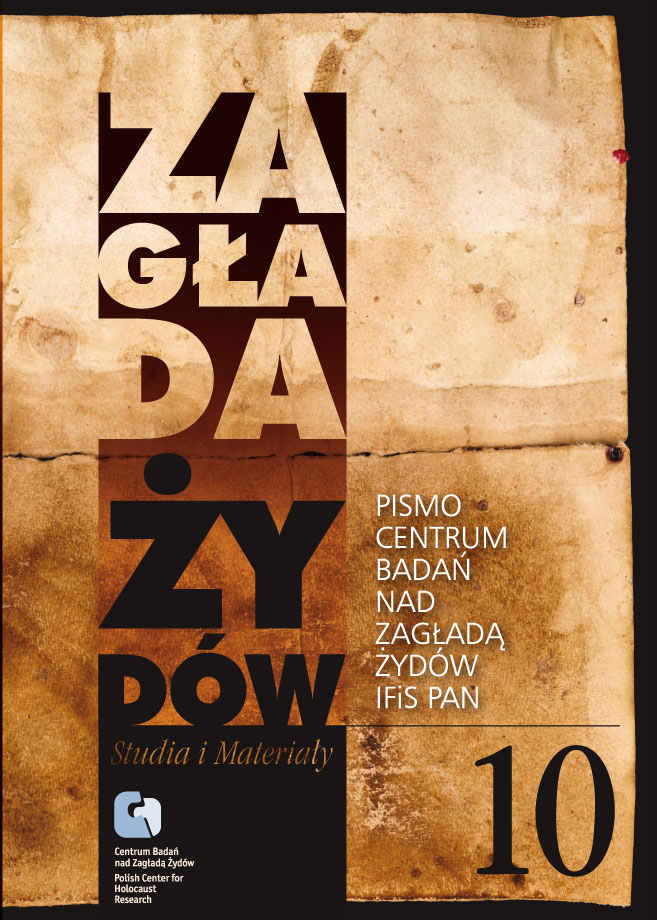Invariable Right to Great Death. Otto Kulka, Landscapes of the Metropolis of Death. Commentary
Zagłada Żydów. Studia i Materiały, No. 10 (2014), Pages: 864-873
Submission Date: 2020-10-26Publication Date: 2014-12-01
 https://doi.org/10.32927/ZZSiM.555
https://doi.org/10.32927/ZZSiM.555
Abstract
As a child Otto Kulka was in the “family camp” (Familienlager) in Auschwitz. Now, many years later Kulka recalls those times. The camp was the place where he matured, got to know the world, had his first contact with great literature, and experienced the happiest moments of his childhood. Kulka discovers that he is still in a way living in Auschwitz, that he had never left that “metropolis of death.” Regularly returning there in his dreams, he reflects on his attitude toward the ubiquitous death, which he perceived as something irremovable, a kind of perpetual, imperative law being fulfilled before his eyes. Knowing no other world, paradoxically Kulka saw death as a manifestation of the operation of justice.
Keywords
death , Auschwitz , city , dream , high culture , adaptive strategy , monotheism
License
Copyright (c) 2014 Author&"Holocaust Studies and Materials"

This work is licensed under a Creative Commons Attribution 4.0 International License.
https://creativecommons.org/licenses/by/4.0
The journal is published under the Diamond Open Access Standard, CC-BY-4.0 Deed - Attribution 4.0 International - Creative Commons
Most read articles by the same author(s)
- Tadeusz Bartoś, Shoah – a New Creation. Metaphysics of Evil , Zagłada Żydów. Studia i Materiały: No. 9 (2013)
- Tadeusz Bartoś, To an Unknown Child , Zagłada Żydów. Studia i Materiały: No. 5 (2009)
- Tadeusz Bartoś, To Forget , Zagłada Żydów. Studia i Materiały: No. 11 (2015)
- Tadeusz Bartoś, To Forgive , Zagłada Żydów. Studia i Materiały: No. 12 (2016)
- Tadeusz Bartoś, In unity, strength - evil. On the ethical consequences of monotheisms , Zagłada Żydów. Studia i Materiały: No. 15 (2019)
- Tadeusz Bartoś, Benedict XVI – a New Stage in the Catholic Understanding of the Shoah? , Zagłada Żydów. Studia i Materiały: No. 5 (2009)
- Tadeusz Bartoś, Übermensch , Zagłada Żydów. Studia i Materiały: No. 13 (2017)
- Tadeusz Bartoś, The Right to Hate , Zagłada Żydów. Studia i Materiały: No. 7 (2011)
- Tadeusz Bartoś, Mały traktat o niestosowności , Zagłada Żydów. Studia i Materiały: No. 6 (2010)
Similar Articles
- Monika Adamczyk-Garbowska, Three Visits to Auschwitz , Zagłada Żydów. Studia i Materiały: No. 14 (2018)
- Piotr Trojański, “We need to send him one, because he is a ‘goldsmith’ or ‘Canada man’.” Case of an Oświęcim Camp Security guard , Zagłada Żydów. Studia i Materiały: No. 11 (2015)
- Agnieszka Haska, Auschwitz from Auschwitz or how to write a bestseller , Zagłada Żydów. Studia i Materiały: No. 16 (2020)
- Małgorzata Preuss, Architects of the Holocaust – an Analysis of Operations of KL Auschwitz-Birkenau Central Construction Board , Zagłada Żydów. Studia i Materiały: No. 2 (2006)
- Ewa Cuber-Strutyńska, Witold Pilecki. Confronting the legend of the “volunteer to Auschwitz” , Zagłada Żydów. Studia i Materiały: No. Holocaust Studies and Materials (2017)
- Anne-Christin Klotz, Spiegel Jasmin, „This is not the time to dream?“ An explorative psychoanalytical and historical reading of selected dreams in diaries written by Jewish victims of the Holocaust in occupied Poland (1939–1945) , Zagłada Żydów. Studia i Materiały: No. 20 (2024)
- Ewa Cuber-Strutyńska, Witold Pilecki. Confrontation with the legend of the “volunteer to Auschwitz” , Zagłada Żydów. Studia i Materiały: No. 10 (2014)
- Nawojka Cieślińska-Lobkowicz, The new Holocaust Museum in Amsterdam , Zagłada Żydów. Studia i Materiały: No. 20 (2024)
- Justyna Kowalska-Leder, Fetishization of Authenticity – The Casus of the Museum and Memorial Site , Zagłada Żydów. Studia i Materiały: No. 17 (2021)
- Zofia Wóycicka, Holocaust Laboratory – New Historical Exhibition at the Former Kulmhof Death Center in Chełmno nad Nerem , Zagłada Żydów. Studia i Materiały: No. 16 (2020)
1 2 3 4 5 6 7 8 9 10 11 12 13 14 15 16 17 18 19 20 21 22 23 24 25 26 27 28 29 30 31 > >>
You may also start an advanced similarity search for this article.
 English
English
 Język Polski
Język Polski



 https://orcid.org/0000-0001-8641-1529
https://orcid.org/0000-0001-8641-1529

